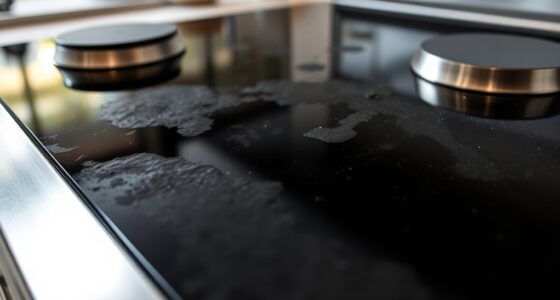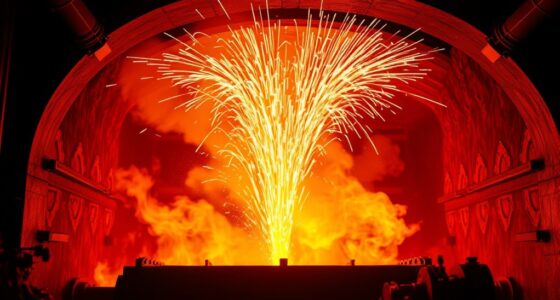Modern wood stoves are highly efficient, typically achieving between 70% and 85% efficiency. Thanks to advanced combustion technologies, better insulation, and emission reduction features, they produce more heat while wasting less fuel and harming the environment less. These improvements mean you get more warmth and cost savings from less wood. If you’re curious about how these innovations work and what else makes modern stoves better, there’s more to discover below.
Key Takeaways
- Modern wood stoves typically achieve efficiency levels between 70% and 85%.
- Advanced combustion technologies maximize heat output while minimizing wood consumption.
- Integrated emissions reduction features contribute to cleaner, more efficient operation.
- Superior insulation and airtight chambers help retain heat and improve overall efficiency.
- Regular maintenance and modern materials extend stove lifespan and sustain high efficiency.

Modern wood stoves have considerably improved in efficiency, making them a popular choice for heating homes sustainably. Thanks to advancements in combustion technology, these stoves now burn wood more completely, which means you get more heat from less fuel. Enhanced combustion processes ensure that the fire’s energy is maximized, reducing waste and making your heating more cost-effective and environmentally friendly. The latest models incorporate sophisticated controls and airflow management, allowing you to optimize the burn cycle for maximum heat output and efficiency.
Modern wood stoves burn more efficiently, providing greater heat with less fuel and reduced emissions.
You’ll notice that modern wood stoves produce fewer emissions than older models, thanks to emissions reduction technologies integrated into their design. These innovations help burn wood more cleanly, minimizing smoke, particulate matter, and other pollutants that could harm air quality. Emissions reduction isn’t just good for the environment; it also means you’re complying with stricter air quality regulations and avoiding potential fines or restrictions. By choosing a stove with advanced combustion technology, you’re actively participating in reducing your carbon footprint and contributing to cleaner air for your community.
Efficiency in modern wood stoves isn’t solely about how well they burn fuel but also how much heat they transfer to your home. Superior insulation, airtight combustion chambers, and controlled air intake all work together to ensure maximum heat output while minimizing heat loss. These features translate to fewer refills, less wood consumption, and more consistent warmth throughout your living space. Some models even include catalytic converters or secondary burn chambers that further improve combustion efficiency, ensuring that nearly all of the wood’s energy is converted into usable heat.
Another key factor in the efficiency of these stoves is their ability to operate with minimal creosote buildup and reduced emissions. This means you spend less time cleaning and maintaining your stove, and you enjoy safer operation with lower risk of chimney fires. The combination of advanced combustion technology and emissions reduction measures results in a cleaner, safer, and more efficient heating option for your home. Additionally, modern stoves often feature advanced materials that enhance durability and heat retention, further boosting overall efficiency. Overall, modern wood stoves offer a significant leap forward in sustainable heating, delivering higher efficiency, cleaner emissions, and better performance than traditional models. By choosing a stove equipped with these cutting-edge features, you’re making a smart investment in both comfort and environmental responsibility.
Frequently Asked Questions
How Does Wood Stove Efficiency Compare to Other Heating Methods?
Wood stove efficiency generally falls around 70-80%, which is competitive with other heating methods like furnaces. You need to pay attention to ventilation standards to guarantee safe operation and maximize efficiency. Using high-quality, seasoned fuel helps improve burning efficiency and reduces emissions. Unlike some electric or gas options, wood stoves require proper maintenance and setup, but with good fuel and ventilation, they can be a cost-effective and efficient heating choice.
What Factors Influence a Wood Stove’s Efficiency?
Think of a wood stove’s efficiency like a finely tuned instrument. Your combustion quality directly impacts how well it burns, while insulation effectiveness keeps the heat inside. Properly seasoned wood, regular maintenance, and sealing gaps boost efficiency. When you guarantee good combustion and maximize insulation, your stove uses fuel more effectively, delivering more heat with less waste—making every log count and saving you money.
Are There Government Incentives for Installing Efficient Wood Stoves?
Yes, you can get government incentives for installing efficient wood stoves. These incentives aim to promote renewable energy and reduce emissions. By upgrading to a modern, high-efficiency wood stove, you may qualify for rebates or tax credits. Check local or federal programs, like the EPA’s programs, to see what’s available in your area. Taking advantage of these incentives helps you save money while supporting cleaner energy solutions.
How Does Maintenance Affect a Wood Stove’s Efficiency?
Maintaining your wood stove considerably boosts its efficiency. You should regularly inspect your ignition systems to make sure they spark properly, providing cleaner, more complete burns. Chimney cleaning is also essential; creosote buildup can restrict airflow and reduce heat output. By keeping ignition systems in top shape and scheduling routine chimney cleaning, you maximize heat transfer, save fuel, and extend the lifespan of your stove, making it more environmentally friendly and cost-effective.
Can a Wood Stove’s Efficiency Decrease Over Time?
Yes, a wood stove’s efficiency can drop dramatically over time, as if it’s lost half its power overnight. You might notice this because of fuel degradation, where wood burns less effectively, and insulation wear, which causes heat to escape more easily. Regular maintenance helps, but even with care, these factors cause efficiency to decline, making your stove less effective and costing you more energy and money in the long run.
Conclusion
In the world of heating, modern wood stoves shine like beacons of efficiency. With advancements that squeeze more warmth from less wood, they turn your cozy space into a well-oiled furnace. Think of them as fiery artists, transforming raw fuel into comforting heat with remarkable skill. So, when choosing your stove, remember you’re inviting a reliable, eco-friendly powerhouse into your home—making every log count like a treasure chest of warmth.











